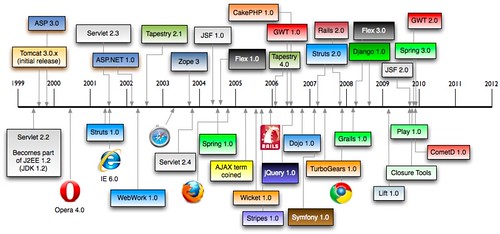How's the ol' Team Doing?
Back in March, I wrote about How We Hired a Team of 10 in 2 Months:
This week, we on-boarded 3 of our final 4 developers. I breathed a big sigh of relief that the hiring was over and we could get back to slinging code and making things happen. As luck would have it, I received an e-mail from my boss on Tuesday that the hiring engine is starting up again and we need to hire 6 more developers. While I'm not anxious to start the Hiring Engine again, I am glad to know it works well and it has helped us build a great team.
We never ended up hiring those additional 6 developers, but we've had quite a ride since March. One of the first commenters on my original post wrote:
I hope that whirlwind of hiring works out for you Matt. But, don't you think it's a bit early to be declaring success?
At that time, we still had a lot of work to do to become a successful team. However, by the end of March, we'd finished our first deliverable - converting a somewhat slow ColdFusion/jQuery/Video webapp into a fast Java/jQuery/Video webapp. The slowness wasn't due to ColdFusion, but mostly performance, caching and YSlow-type optimizations. At that time, we surprised the folks that were in charge of our app. They didn't think we'd finish so fast and it took them awhile to decide what to do with our work.
While we were waiting for the product folks to launch our app in April/May, we decided to experiment with developing some new clients. So we wrote an iPhone app, an Android App, an iPhone/Android/iPad/HTML5 version of our webapp and a Blu-ray client. All of these applications used our webapp's backend RESTful services and we were able to learn the SDKs and implement all the apps in a matter of weeks. In May, we demoed all our clients and got rave reviews from executives. We celebrated that afternoon with a big sigh of relief.
The glowing from our many-clients demo was short-lived. A week later, we were asked to enhance our iPad app to include TV-Remote type features, namely channel-changing and DVR functionality. After freaking out and trying to figure out how to deliver such an app in a week, the demo was rescheduled and we were afforded 2 weeks to build the app. After much frantic development, we were able to complete the app in time and the demo was published to YouTube a couple months later.
In June, if you asked me if we were a successful team, I would've definitely said "Yes!" We'd been asked to develop apps for 3 different demos and we delivered on-time.
The remainder of June and July we slipped into a bit of limbo where we weren't asked to develop anything, but simply maintain and enhance the stuff we'd already developed. After a few weeks of doing this, several of us began to wonder if the apps we'd developed would ever see the light of day. We expressed this concern to our VP and a new idea was hatched: The 60-Day Push.
The 60-Day Push was designed to eliminate politics and meetings and allow us to develop a 3-screen (PC, iPad, TV) experience for our video content. We decided to aim high and try to complete most of the work in 30-days, so we could do executive demos of our progress. We started all our applications from scratch, split into Services, Portal, TV and iPad teams and worked with Method to implement a slick design for all our apps. I'm proud to say we delivered yet again and there were many proud moments as we demoed to the top executives of the company.
In early September, after doing several demos, we were approved to launch and we've been working towards that goal ever since. We feel we have several weeks of work to coax our DemoWare into RealWorldWare, but the momentum is there and the end of the tunnel is in sight.
As a further sign of our success, we're moving into a new office in LoDo next week. This also means the End of an Era, where the Raible Designs' office across from Forest Room 5 will cease to exist. We (Goodwill, Scotty, Country Bry and I) first moved into this office while working for Evite in April 2009. It's been a fantastic location, a facilitator of extensive collaboration and host to many dart games, FACs, bird-dog spottings and way too many Mom Jokes.
As part of our transition, I'll be looking for renters to fill out the rest of my lease (through March 2010). If you're looking for a sweet location for 5-6 people in Denver's Highlands (near the REI store downtown), please let me know.
Also, there's a good chance my team will continue to grow as we move our apps into production and start ramping up for millions of users. If you're a strong Web or Java developer with social skills and a Ditchdigger attitude, I'd love to hear from you. We probably won't be hiring until January, but that doesn't mean we can't start talking now.


